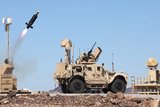Royal Australian Navy tests ScanEagle
A team from the Royal Australian Navy’s Unmanned Aircraft Systems (UAS) unit has been deployed to Christmas Island to test the limits of the Boeing Insitu ScanEagle UAS, the navy announced on 3 October.
The six-member detachment is operating from the island’s aerodrome to test its ability to conduct long term UAS operations without support. The deployment and location have enabled offshore flights of up to ten hours duration.
ScanEagle has been equipped with a Visual Detection and Ranging (ViDAR) payload, an airborne wide area maritime search and surveillance sensor.
Developed by Sentient Vision Systems, ViDAR uses a camera to scan and record a 180-degree view and identify anomalies through a complex software programme. Operators are alerted to potential targets in real time, to allow closer inspection to be undertaken using the ScanEagle’s more powerful electro-optical camera.
The deployment has helped the navy consolidate operator training and gather test data and experience in an operational-like environment. The trial represents the first time an all-navy UAS crew has conducted all aspects of the set-up, testing and validation flights without support of the manufacturer.
The team had achieved around 82 flight hours, with over 12 hours of specific ViDAR operation, by the fourth week of the three month deployment. The trial is scheduled to end in November and will help inform the use of ViDAR at sea early in 2017.
Related Equipment in Defence Insight
More from Uncrewed Vehicles
-
![Cummings Aerospace showcases Hellhound loitering munition designed for US Army’s LASSO programme (video)]()
Cummings Aerospace showcases Hellhound loitering munition designed for US Army’s LASSO programme (video)
Cummings Aerospace presented its turbojet-powered Hellhound loitering munition at SOF Week 2025, offering a man-portable solution aligned with the US Army’s LASSO requirements.
-
![SOF Week 2025: PDW unveils attritable FPV drone for SOF operations at scale]()
SOF Week 2025: PDW unveils attritable FPV drone for SOF operations at scale
PDW has revealed its Attritable Multirotor First Person View drone at SOF Week 2025, offering special operations forces a low-cost, rapidly deployable platform for strike and ISR missions, inspired by battlefield lessons from Ukraine.
-
![SOF Week 2025: Teledyne FLIR white paper provides guidance on reusable loitering munitions]()
SOF Week 2025: Teledyne FLIR white paper provides guidance on reusable loitering munitions
Teledyne FLIR is highlighting the emerging requirements for 'recoverable and re-usable' loitering munitions across the contemporary operating environment during this week’s SOF Week conference in Tampa, Florida.
-
![SOF Week 2025: Kraken Technology group debuts K3 Scout USV in North America]()
SOF Week 2025: Kraken Technology group debuts K3 Scout USV in North America
High-performance maritime industry player Kraken Technology Group, based in the UK, has used the SOF Week conference in Tampa, Florida this week to debut its K3 Scout uncrewed surface vessel (USV) to the North American market.
-
![Palladyne AI and Red Cat to demonstrate capabilities for autonomous drone swarms to the US military]()
Palladyne AI and Red Cat to demonstrate capabilities for autonomous drone swarms to the US military
Red Cat and Palladyne AI recently conducted a cross-platform collaborative flight involving three diverse heterogeneous drones.
-
Jammer resistant drone designs spark search for countermeasures
The Russia-Ukraine conflict has driven another stage of evolution for drones and the counter measures to defend against them.

























